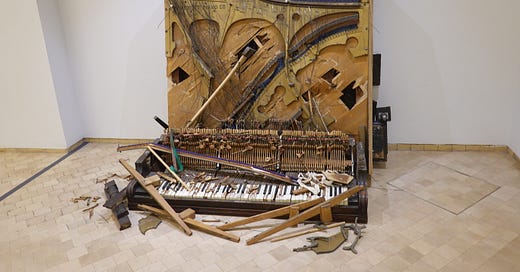Violence Against Violins
Last Saturday, I attended the closing event for Raphael Montañez Ortiz’s retrospective at El Museo Del Barrio, a museum championing Latinx art.
The event included a “Paper Bag Destruction Concert,” orchestrated by Ortiz himself, where audience members wrote annoyances on scraps of paper which were thrown onstage to be read aloud and shredded.
Among the annoyances: racism, people rude to waiters, shoelaces, and being horny.
Ortiz, the museum’s founder, was raised in a Puerto Rican family in New York. The author of Destructivism: A Manifesto (1962), he was, and is, a key figure in the Destructivist art movement.
Among Ortiz’s collaborators was Charlotte Moorman, better known as “the topless cellist,” who organized Fluxus happenings around New York City. In 1968’s One for Violin Solo, scored by Nam June Paik, she ceremonially smashed a violin.
The retrospective included Ortiz’s piano sculptures, their keys like broken grins. It also included footage of a “Piano Destruction Concert” in which Ortiz goes at the instrument with an axe.
The performance, the museum label reads, was an act of defiance against “Western ideals of high culture.”
Ortiz’s sculptures reminded me of another that I recently saw at the Museum of Modern Art. There, a fiddle filled with corn, the yellow kernels spilling out from the instrument’s belly.
The work, by Victor Grippo, is part of Vida, Muerte, Resurrección (1980), a commentary on Argentina’s military dictatorship.
Indeed, there’s a violence to the sculpture, whose title means “Life, Death, Resurrection.” It makes me want to hold the violin by its neck and toast it over the fire like jiffy pop.
I was also reminded of Violoncelle dans l’espace (1967-8) by French-born artist Armand Fernandez, or Arman, which I saw a couple years ago at the National Galleries of Scotland.
“Cello in Space” is not an intergalactic opera, as the title sounds. It is, rather, a sculpture capturing the moment of an instrument’s explosion.
Pieces of wood, broken strings, and a disembodied endpin float in polyester resin. Like an insect encased in amber.
Looking at the broken strings, I thought of how a cello C-string will leave a nasty welt if it snaps on your skin. A bit like how a bee leaves a stinger in you on its way out from this world.
I’ve been thinking a lot lately about the destruction of instruments, not just in “high art” but also popular culture.
There’s, of course, the trope of guitarists smashing and burning their instruments onstage (Jimi Hendrix most famously did this in 1967.)
Last year, the Instagram account “Violin Torture” was featured in a New Yorker article by Jennifer Gersten titled “The Urge to Destroy a Violin.” The account’s owner, Tyler Thackray, calls his workshop a “dungeon.”
In one of Thackray’s experiments, he removes a violin’s bridge and strings, and places it in a beehive. He leaves it there for years, the instrument’s recesses filling with sticky hexagons. Finally, he reassembles and plays the violin.
Gersten’s article fails to situate “Violin Torture” in terms of Destructivist art. It also never explicitly draws the connection between the violin’s shape and the human, specifically female, body.
It does, however, point out that violins are made from bodily materials: ivory, horsehair, animal glue, sheep gut.
Indeed, there’s something masochistic about this tradition of destroying instruments. Their forms acting as proxies for our own.
It should also be said that, between calluses and tendonitis, musicians are not always the kindest to their bodies.
There is a lot more to say here. But, for now, you’ll have to wait for Organologies, a collection of essays about turning into a cello, currently in progress.







